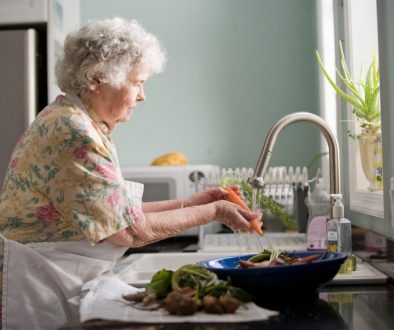‘No decision about me, without me’?
With cottage hospitals under threat, a shortage of doctors and dentists, lack of out of hour’s services and ‘save our surgeries’ petition against the withdrawal of the Minimum Practice Income Guarantee; (rural) healthcare may become more patchy and rationed. At the same time, the Health and Social Care Act 2012 is intended to safeguard the NHS – tackling its problems, avoiding a crisis and empowering patients. But what do rural health indicators tell us? How is healthcare delivery changing? And is it empowering rural residents? Jessica Sellick investigates.
For Government, clinicians and patients the NHS needs modernising: the pressures being placed upon it are snowballing with an ageing population (increasing demand) and more sophisticated and expensive treatment options becoming available (increasing costs – with new medicine outlays rising by £600 million a year). While the NHS budget has been ‘protected’ despite reductions in other service areas; simply doing the same things in the same way is not going to be sustainable. What new organisational and funding models of healthcare are emerging? What does this mean for rural patients? I offer three points.
First, the impact of rurality on health and healthcare services. The good news according to Defra’s Statistical Digest of Rural England 2014 is that if you live in the countryside your life expectancy increases and you are less likely to die prematurely from cancer, stroke or coronary heart disease: forecasters predict that, on average, people born in very rural areas will live 1.5 to 2 years longer than those in major urban areas. At the same time – and here’s the bad news – people living in rural areas have lower overall accessibility to key services (including GPS, hospitals) and apparently patients are more likely to access healthcare if it is nearby. Yet the rural premium that exists in providing healthcare services (i.e., from having an ageing population and sparsity) is not always recognised in funding arrangements.
A report by the Environment Food and Rural Affairs Committee in 2013 took England’s most rural Primary Care Trust (PCT) area – North Yorkshire and York – and found it received significantly less funding than PCTs in nearby urban areas: “The [North Yorkshire and York] Trust gets £1,477 per head of population compared with a regional average of £1,690, while the PCT covering Barnsley receives £1,903. In Sheffield, the PCT is awarded £1,701 and in Leeds the figure is £1,552”.
More recently, this discrepancy in health finance has been highlighted in the new funding arrangements for GP practices. From April 2014, and over the next 7 years, the Department for Health (DH) will be removing the Minimum Practice Income Guarantee (MPIG). Typically, just over half the money a GP surgery receives is in the form of a ‘global sum’. The exact amount a practice receives is calculated based on the workload theoretically generated by each of its patients. This was a change from the old contract (pre 2003), where payment was based on the number of doctors within a practice, and was intended to distribute funds more fairly to areas that needed it most.
However, when the new contract was introduced, 90% of practices found that the redistribution led to a significant drop in their core funding. To ensure this did not happen, a correction factor was applied to the global sum so that in instances where this happened income would be restored to at least 2003 levels. MPIG, therefore, is used to top up practices core income and is calculated using the following formula: MPIG = global sum via formula + correction factor. The removal of MPIG from April (affecting some 63% of all GP surgeries) is intended to make practice funding ‘more equitable’. Yet some surgeries – those with less than 4,000 patients, on more than one site and already struggling to make ends meet for example – stand to lose most.
According to the Government, 50% of practices will gain income and 50% will lose income from the withdrawal of MPIG; with the extent of the losses ranging from ‘a few pounds to hundreds of thousands of pounds’ per practice. One North Yorkshire GP estimates that his practice could lose around £78,000 a year, affecting the viability of services and possibly the practice itself.
The outlook for hospital funding is equally gloomy: of the 102 NHS organisations (mainly hospitals) which have their finances overseen by a new body called the Trust Development Authority (TDA), many are already struggling to balance their books. Recent board papers from the TDA revealed that out of 147 NHS Foundation Trusts, 33 expect to be overspent by the end of March 2014.
With David Prior, chair of the Care Quality Commission (CQC), warning that without “major long-term change, the UK’s health service will go bust”; what these statistics open up is a debate between how to improve levels and standards of care amid funding deficits. How can we have sustainable financing of the health sector? And how can we attend to what academics call “clinical peripherality”, a recognition that rural health practitioners provide a broader range of services to smaller populations scattered over wider areas or more difficult terrain than their urban counterparts? Defra is working with the DH to collect data on the cost of health service provision in rural areas to investigate any inequality of funding.
Second, what ‘new’ approaches to the commissioning and delivery of healthcare are emerging? This diagram explains the structure of the NHS post April 2013. As an organogram it illustrates how organisations such as primary care trusts (PCTs) and strategic health authorities (SHAs) have been abolished, and maps new organisations such as clinical commissioning groups (CCGs). Practically, it explains how NHS services will be opened up to competition from providers that meet NHS standards on price, quality and safety (overseen by a new regulator: Monitor) and the role of local authorities in assuming responsibility for budgets for public health and establishing Health and Wellbeing Boards (HWB).
Pivotal to this reorganisation game is the Health and Social Care Act 2012. The key legislative changes include (a) clinically led commissioning – Clinical Commissioning Groups (CCG) supported by the NHS England now procures services for their populations rather than primary care trusts. The ‘Any Town’ Toolkit produced by NHS England in January 2014 – which includes a rural model – enables CCGs to map how interventions could improve local health services and close the financial gap. (b) Health providers such as NHS Foundation Trusts are now free to innovate and deliver services. Similarly, patients are able to choose services which best meet their needs, including from charity or independent providers, as long as they meet NHS costs (!)
Practical examples of where models of service delivery are changing include Central Surrey Health (CSH), a social enterprise owned by the nurses and therapists which provides a range of services for adults (from dietetics to physiotherapy) and children and families (from health visiting to immunisations). Virgin Care (part-owned by Richard Branson’s Virgin Group), which provides over 270 services across the country – from running seven community hospitals in Surrey to clinics in Northampton and Teesside.
And Circle which runs the first hospital to be privatised in England — Hinchingbrooke in Cambridgeshire. In social care services, focus independent adult social work C.I.C; is a Social Work Practice working within North East Lincolnshire, commissioned by the local CCG and Council to take charge of all statutory adult social work across the local authority area. Focus is one of seven central Government pilots testing the outsourcing of statutory social work functions to independent organisations. The pilots are part of central Government’s wider agenda of the Big Society. A key commitment is to give public sector workers a new right to form employee-owned cooperatives and to bid to run the services they provide.
(c) The creation of Public Health England (PHE) to drive improvements in the public’s health. Here, Local Authorities are the new leaders of the local public health system and making judgements about the use of the public health grant to ensure that they have the right people to help them meet the challenges which they face. The Local Government Association (LGA) is working with PHE and other bodies to prepare good practice guidance on the skill mix which Councils may want to consider in a local public health team. Councils are therefore left joining up the local NHS, social care, health improvement and wellbeing to provide integrated care.
The health landscape is always changing – but the scale of re-organisation (with so many organisations involved in designing and delivering healthcare, lots of jargon and acronyms) can seem perplexing. On the one hand, the emerging landscape presents an opportunity to break away from a ‘biomedical’ approach and move towards a ‘social’ approach with the vertical integration of clinical and community services.
On the other hand, will it lead to further fragmentation of services, especially in rural areas? Is the NHS becoming a brand with multiple providers including social enterprises and for-profit commercial companies? Will funding decisions result in a variation and widening of health inequalities? And what is the relationship between Government action and personal responsibility (with a shift from the state to the patient and the Big Society)?
Third, and most importantly of all, what does this mean for patients? Although the NHS is rated highly as providing one of the best healthcare systems in the world in terms of efficiency, effective care and cost; it often fares less well in providing patient-centred care (see scorecards and surveys from the Commonwealth Fund). For example, the All Party Parliamentary Group (APPG) on Parkinson’s disease recently produced its ‘Failing to Care‘ report which described parts of the NHS as having “intimidating, humiliating, unfriendly, exhausting, degrading, aggressive, frustrating and adversarial” procedures.
In December 2013, Healthwatch England launched a three-month consultation with patients, care users and their families to shape its strategy over the next two years and create a ‘rights based framework’ that puts people at the heart of health and care. In many ways this follows on from a Government drive since 2010 to liberate the NHS and provide a means for patients to become more involved in their care.
While the desire to empower patients in the design and delivery of their care is to be applauded – for it returns agency when illness or disease has taken it away – this isn’t always an easy thing for some patients to live with. It can make patients want stuff (rationally or irrationally) and in making choices requires them to make really painful trade-offs (public or private? Near or far from home?) How can we ensure shared decision making between patients and clinicians leads to better health outcomes and reduces cost?
Jessica is a researcher/project manager at Rose Regeneration; an economic development business working with communities, Government and business to help them achieve their full potential. Jessica has undertaken a variety of projects on services, including research for Defra on alternative service delivery and local level rural proofing. In 2013, she organised an event for the RSN on inequalities and deprivation. More information about the RSN’s work on health services and the Rural Health Network can be found here. Jessica can be contacted by email jessica.sellick@roseregeneration.co.uk or telephone 01522 521211. Website: www.roseregeneration.co.uk Twitter: @RoseRegen


